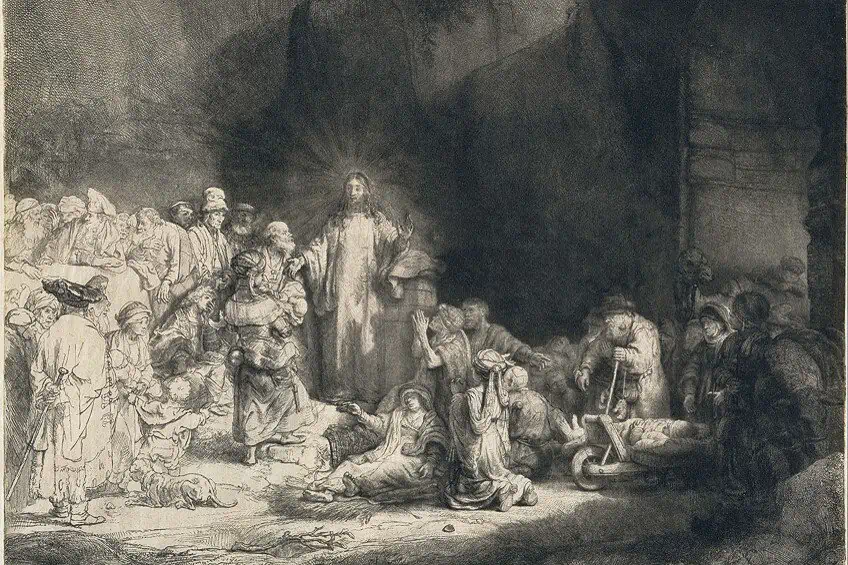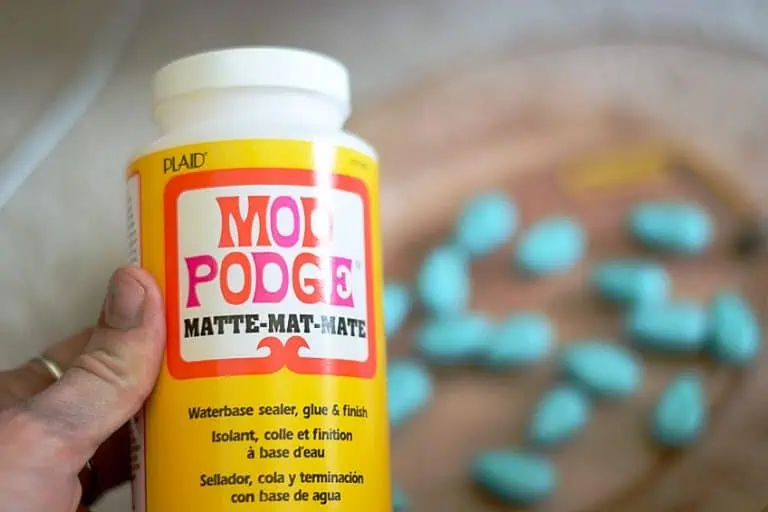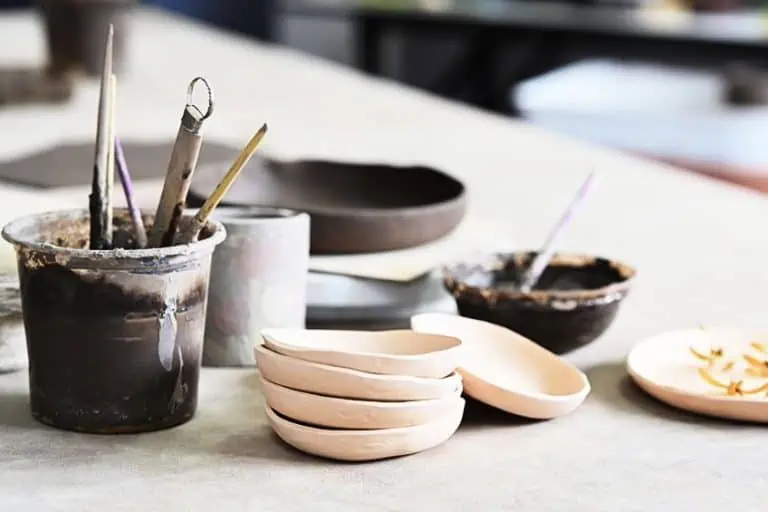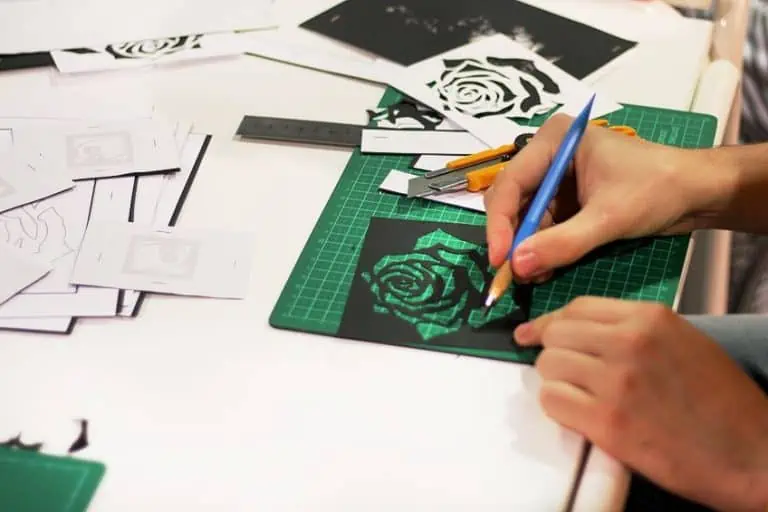What Is Etching in Art? – Unveiling the Magic of Etching
This post may contain affiliate links. We may earn a small commission from purchases made through them, at no additional cost to you.
What is etching in art? This method of printmaking has been in use for several centuries, and it’s worth having a closer look at it. Today, we will be discussing the history of etching, the traditional etching process, and some of the artists who have made use of this technique over the years. Let’s get started and have a look at etching!
Table of Contents
What Is Etching in Art?
Etching is a form of intaglio printmaking. This means that it is a means of leaving a design of some kind into a metal plate that can then be used to produce prints. The completed metal plate is filled with ink and pressed against a surface, such as paper, to leave behind a reproducible image. However, intaglio is simply the name for a larger family of this general technique, and there are specific varieties. The etching process is only one of those techniques.
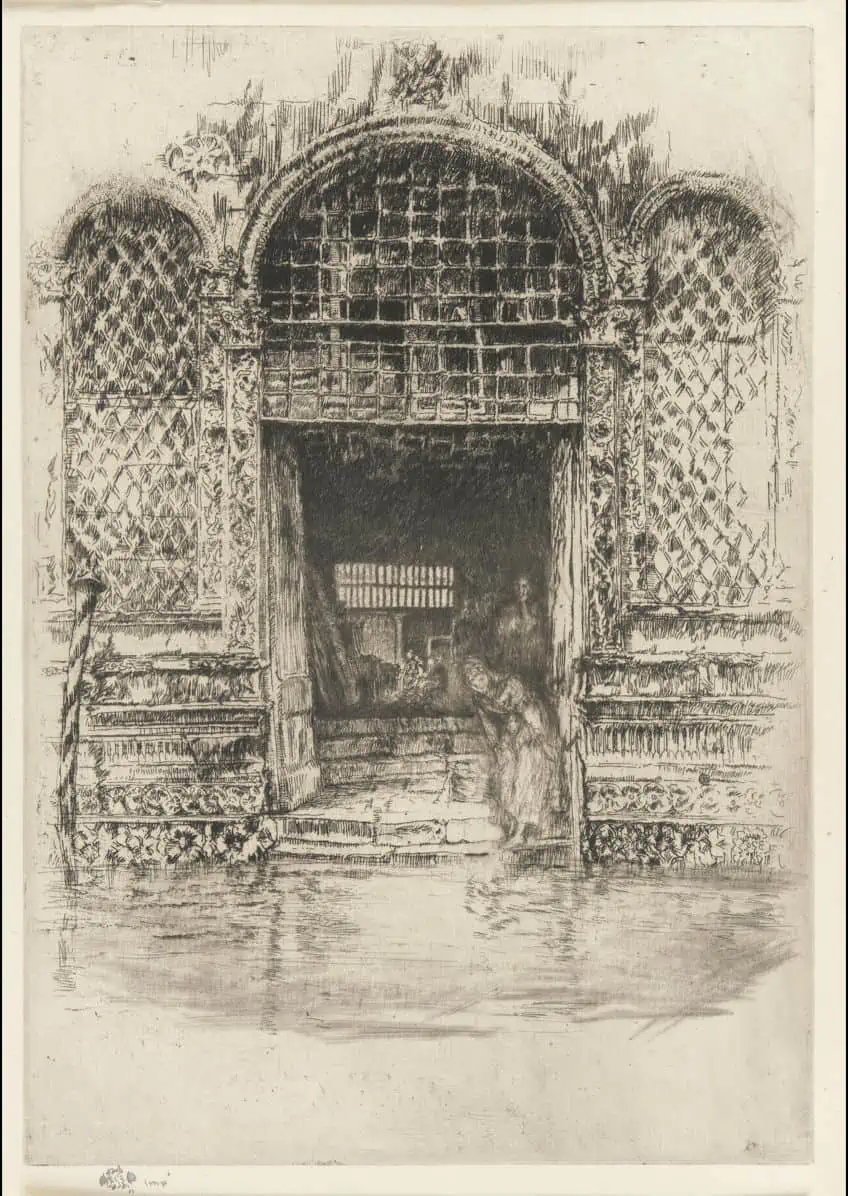 The Doorway (1880) by James McNeil Whistler; James McNeill Whistler, Public domain, via Wikimedia Commons
The Doorway (1880) by James McNeil Whistler; James McNeill Whistler, Public domain, via Wikimedia Commons
Etching printmaking, in particular, involves the use of an acid-resistant ground that is applied to the surface of the metal plate, and the design of the artist’s choice is then scraped through that resistant material to expose the metal underneath the surface of the metal plate. The plate itself is then placed into an acid bath that chemically cuts into those etched sections.
However, the etching process will be discussed in more detail below. Before that, let’s first have a look at the history of etching art.
The History of Etching in Art
Forms of etching have existed for an immensely long time throughout human history. Some of the oldest examples of etching existed in antiquity and were used for decorative purposes. Forms of etching were used in various beads as early as the 3rd millennium BCE. However, the methods were significantly different at the time. Those earliest methods appear to have been a form of alkaline etching as opposed to the acidic etching that would become far more prominent in later centuries.
Some of these ancient beads were found in Sumerian tombs, Ancient Egypt, and the Indus Valley.
However, some later examples of the etching process could be found in the work of goldsmiths and metalworkers during the medieval period. These earlier users of etching methods would use this process to create intricate designs in a variety of items, such as weapons, armor, and crockery. It appears that this early form of the style is significantly older than what is considered to be the more contemporary understanding of the etching process.

That process would originate in Germany through the work of Daniel Hopfer. This figure was an armorer who made use of a printmaking method that was closer to the present understanding. However, many of his sets of armor do still exist and can be studied to show their similarity to the later printmaking techniques that were developed.
The use of copper plates for printmaking started in Italy in the 15th and 16th centuries, and this was when the method started to become popular.
The etching process would soon become the primary competition against engraving, but the difficulty of this newer form was that it required both a level of artistic ability in the creation of the print itself, but also a more technical ability in the realities of working with the grounds and acids that were needed. This also presented health risks to those who engaged in this type of work.
 Christ Healing the Sick (1649) by Rembrandt van Rijn; Rembrandt, Public domain, via Wikimedia Commons
Christ Healing the Sick (1649) by Rembrandt van Rijn; Rembrandt, Public domain, via Wikimedia Commons
Advancements would be made in the etching technique when Jacques Callot entered the scene in the early 17th century. He made a number of technical improvements in this technique. He created a harder and improved recipe for the acid-resistant ground that was necessary for the process, and this started to replace the wax-based approach that had been used before. This also allowed for the etched lines to be more deeply bitten by the acid, and this led to the etching prints lasting significantly longer than those that had existed before.
In addition to this, his new recipe decreased the risk of the acid reaching other parts of the plate which could ruin the whole design.
This meant that he essentially created the means through which artists could have greater freedom in their creations without needing to worry as much about the inherent dangers of making use of an acid-based formula that could damage plates in a way that engravers never needed to be concerned about. This only added to the proliferation of etching printmaking as a preferred method. However, this was not all that Callot managed to achieve. In addition to this, he created more methods of “stoppings-out”.
This is the process whereby acids can be better manipulated and stopped part way through the process of biting into the metal. This allowed for deeper and shallower sections in the plate, and this meant that the final print could have greater use of detail. This is also why many of his prints were relatively small but were full of details that many other printmakers had not been capable of producing.
It was only through a figure known as Abraham Bosse, a follower of Callot, that his techniques started to be used throughout Europe. He published a manuscript about etching that was translated into multiple languages and led to the etching process being further expanded by numerous other figures, such as Rembrandt. However, as the 19th and 20th centuries rolled in, these methods became less common as others were developed.
This is why there are no major figures known for etching today even though the method is still widely practiced.
There are more people making use of etching techniques than ever before, but digital forms of image reproduction have become significantly more common ever since the internet age has exploded around the world. The traditional etching process is still used by many regardless of that, so let’s have a look at that process.
The Traditional Etching Process
While etching art has changed significantly over the years and there are contemporary forms of this particular technique, the traditional method can still be utilized. In terms of the traditional etching process, a metal plate that is generally made of a material like steel, zinc, or copper is used. That metal plate is then covered in an acid-resistant ground, such as a wax formula. The etching artist would then scrape away at the ground and produce the desired design through the use of an etching needle.
Once the design has been completed, the plate would then be exposed to an acid bath.
The acid would, as the waxy layer is resistant, ignore those sections and instead enter the grooves that have been produced. The acid reacts with the metal within the grooves and leaves behind a pronounced design. The resistant material can then be cleaned off so that the final etched plate is all that remains. Once the plate itself has been completed, the etching printmaking process can begin. The plate is covered in ink, but the surface is wiped clean so that the ink is only present within the recesses of the plate.

That plate can then be applied to a surface, such as paper, and the plate will leave behind a print that can be replicated many times. While these completed prints can eventually wear out, it takes a significantly long time for this to be the case. However, the plate can be repaired or replaced when it does eventually wear out. In addition, it is worth noting that the acid-resistant ground could be made of either a softer or harder material.
The softer material never truly hardens, and this allows for far smoother prints to be created, whereas harder materials allow for the opposite. This is only one of the ways in which etching art can be as variable as any other artistic medium.
In the traditional etching process, the acid-resistant ground was made of beeswax and asphaltum, but these materials can be toxic. By the 1990s, new materials had been developed that made etching techniques significantly safer and healthier. This has allowed modern artists to continue making use of etching without needing to worry about some of the prior issues that plagued this longstanding medium.
Etching in Printing
The reason that etching has a long and storied history in printmaking is because of the way in which etching can serve as a relatively easy and inexpensive means of producing reproducible artworks. Other methods, such as engraving, are often significantly more difficult to produce. This means that etching is often a preferred medium through which printmaking can be achieved.
In addition, the relative ease of the materials meant that etching allowed artists to have significantly more freedom in how they were able to apply themselves to the medium.
Etching allowed artists to make use of various tools to create art through the acid-resistant grounds rather than being constrained by the harsher methods needed for engraving. Additionally, etching allowed for the easy production of plates that could be used in printmaking. Etching became a popular medium through which numerous scenes could be produced, and it became a particularly popular medium for the creation of illustrations in books.

Famous Artists Who Have Used Etching
There have been many artists over the centuries who have made use of etching in art, and we are going to briefly have a look at only five of the most important figures in this space. Some of these artists were pioneers in etching techniques while others were masters of the form. So, let’s have a look at them.
Albrecht Dürer (1471 – 1528)
| Movement | High Renaissance |
| Years | 1471 – 1528 |
| Place of Birth | Nuremberg, Germany |
| Known For | Knight, Death and the Devil (1513) and Saint Jerome in his Study (1514) |
 Saint Jerome in his Study (1514) by Albrecht Dürer; Albrecht Dürer, CC0, via Wikimedia Commons
Saint Jerome in his Study (1514) by Albrecht Dürer; Albrecht Dürer, CC0, via Wikimedia Commons
Albrecht Dürer was a German artist who is generally considered to be the Father of Etching. He invented the etched stroke technique in which a blunt instrument is used to create both darker and wider lines in the plate. Many of his etchings depicted religious and mythological figures and scenes.
Rembrandt (1606 – 1669)
| Movement | Dutch Golden Age |
| Years | 1606 – 1669 |
| Place of Birth | Leiden, Netherlands |
| Known For | The Death of the Virgin (1639) and The Hundred Guilder Print (1648) |
 Christ Crucified Between the Two Thieves (1653) by Rembrandt van Rijn; Rembrandt, CC0, via Wikimedia Commons
Christ Crucified Between the Two Thieves (1653) by Rembrandt van Rijn; Rembrandt, CC0, via Wikimedia Commons
Rembrandt was a Dutch painter and one of the most important figures in the Dutch Golden Age. He is considered to be one of the greatest users of etching. He experimented with numerous acid-resistant grounds, acids, and inks to produce various effects in his work. Over the course of his career, he created over 300 etchings.
His work depicted portraits, biblical scenes, landscapes, and others.
Francisco Goya (1746 – 1828)
| Movement | Romanticism |
| Years | 1746 – 1828 |
| Place of Birth | Fuendetodos, Spain |
| Known For | Here comes the bogeyman (1799) and This is worse (1815) |
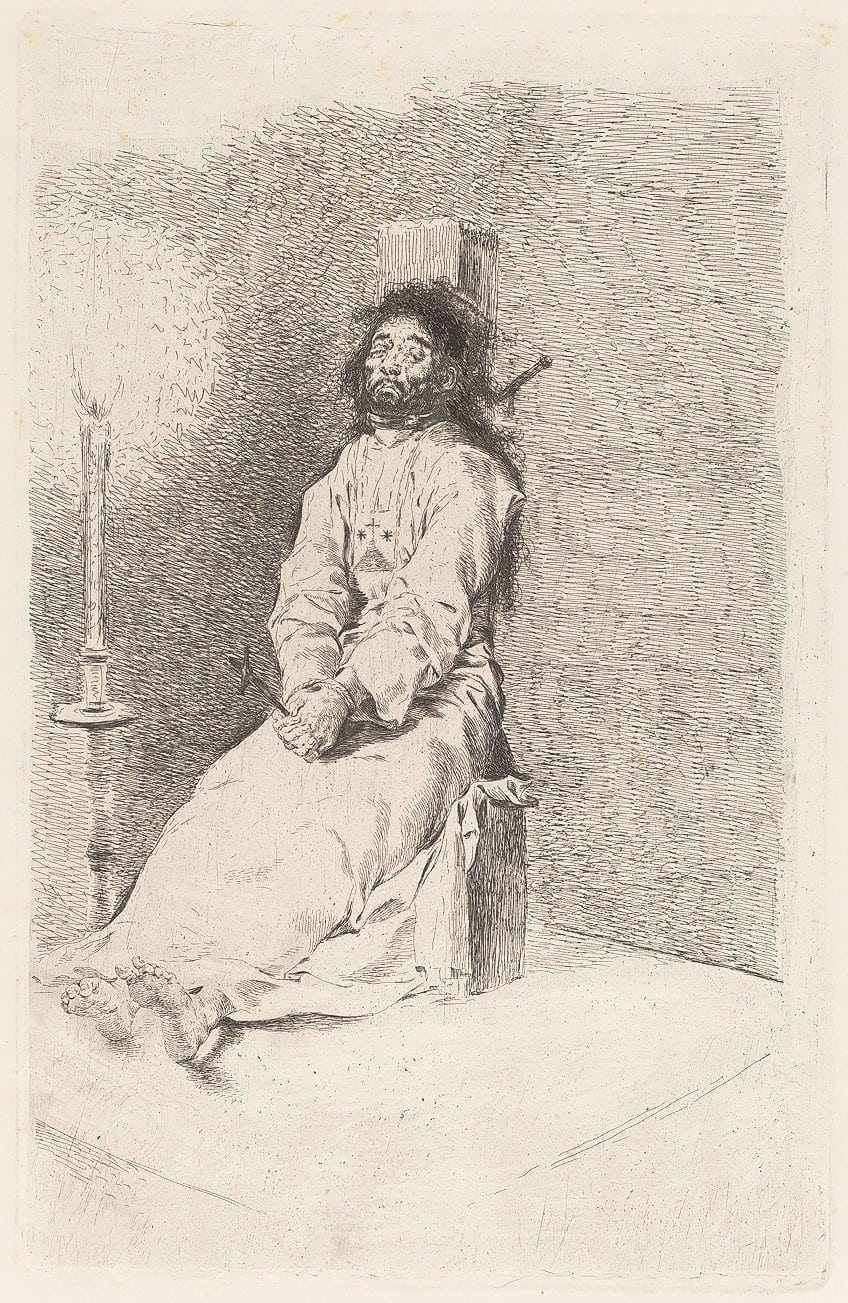 The Garroted Man (before 1780) by Francisco Goya; Francisco Goya, Public domain, via Wikimedia Commons
The Garroted Man (before 1780) by Francisco Goya; Francisco Goya, Public domain, via Wikimedia Commons
Francisco Goya was a Spanish artist who made use of etching but combined it with other intaglio techniques. His work specifically combined etching and aquatint methods to produce a sense of texture in his printmaking. Many of the prints that he produced were expressions of social commentary and were vehemently anti-war in their messaging.
Pablo Picasso (1881 – 1973)
| Movement | Cubism and Surrealism |
| Years | 1881 – 1973 |
| Place of Birth | Málaga, Spain |
| Known For | The Frugal Repast (1913) and Vollard Suite (1930 – 1937) |
Pablo Picasso was a Spanish artist who was active in a large number of artistic mediums, but he created over 2,000 prints over the course of his career. One of the techniques that he made extensive use of was etching, and he used it to create images in the Cubist, Surrealist, and Expressionist traditions.
Lucian Freud (1922 – 2011)
| Movement | Surrealism and Realism |
| Years | 1922 – 2011 |
| Place of Birth | Berlin, Germany |
| Known For | Girl with a Kitten (1947) and Reflection with Two Children (1965) |
Lucian Freud was a British artist who was a part of the famous Freud family of which Sigmund Freud is the most famous member. His works are remembered for their realistic portrayals, and his etchings are specifically noted for the use of single lines or the minimal use of strokes. Many of these etchings were made of friends and family.
And so, we come to the end of this short look at etching. We have asked the question, “What is etching in art?”, and have come away with some answers. We have examined the history of etching, the traditional etching technique that is still used to this day, and some of the artists best known for making use of this process. Hopefully, you have learned a good deal about etching in art today, but there are still many prints for you to peruse!
Frequently Asked Questions
What Is Intaglio?
Intaglio is a form of printing and printmaking that involves the use of metal plates that are used as a medium into which an image is carved. The recesses that are then produced during the process are filled with ink, wiped of excess ink, and pressed against a surface, such as paper, to leave behind a print of some kind. There are various examples of intaglio techniques, such as engraving, drypoint, and etching.
What Is Etching in Art?
Etching is a subset of intaglio printmaking. The general idea is that a metal plate is covered in an acid-resistant material that allows an etching artist to carve through it and toward the metal underneath. The plate is later exposed to an acid bath and the acid enters the grooves created during the etching process. Once the acid has eaten into the metal to the desired depth, the plate is cleaned (including the removal of the acid-resistant material), and the plate can be used in printmaking thereafter.
Why Was Etching Used in Printing?
Etching is a very useful means of producing prints that can be applied to a surface, such as paper, and it is a relatively easy means of producing prints. Some other forms of intaglio are significantly more difficult, and etching allows for the production of a reproducible image that can be reused hundreds of times before it starts to show wear and tear. The method is still used to this day, although more contemporary etching techniques have since been designed.
What Is an Etching Painting?
An etching painting is a painting that has been made through the etching process. The paintings that have been produced through the etching technique can be easily reproduced, but this is considered to be an unusual form of painting as most painting is instead produced on another medium, such as canvas. However, when the etching process is used, it allows for images that can be recreated rather than existing as singular items.
What Are the Most Common Intaglio Techniques?
There are a number of different intaglio techniques. There is the traditional etching method, which involves the use of an acid-resistant material, but there are also drypoint methods, which does not use acid at all, and aquatint methods, which makes use of a powdered resin. Etching is part of the far larger intaglio family though, and so there are a number of intaglio methods that can be used in place of traditional etching techniques.
In 2005, Charlene completed her wellness degrees in therapeutic aromatherapy and reflexology at the International School of Reflexology and Meridian Therapy. She worked for a company offering corporate wellness programs for several years before opening her own therapy practice. In 2015, she was asked by a digital marketer friend to join her company as a content creator, and it was here that she discovered her enthusiasm for writing. Since entering the world of content creation, she has gained a lot of experience over the years writing about various topics such as beauty, health, wellness, travel, crafting, and much more. Due to various circumstances, she had to give up her therapy practice and now works as a freelance writer. Since she is a very creative person and as a balance to writing likes to be active in various areas of art and crafts, the activity at acrylgiessen.com is perfect for her to contribute their knowledge and experience in various creative topics.
Learn more about Charlene Lewis and about us.
